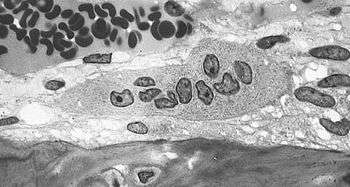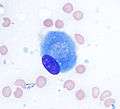Bone cell
Bone cells, which are found within the bone tissue, make up the skeletons of vertebrates. There are different types of bone tissue in a bone, made up of various types of bone cells: there is the cortical bone, which is the compact tissue of the hard outer part (cortex) of the bone; the cancellous bone, which is the spongy tissue inside of the compact cortex; and the subchondral tissue, which is the smooth tissue at the end of each bone.[1] Bone cells all work together inside of the bones to help keep up the skeletal system. The bone cells do many things for the skeletal system, such as the development of new bones and continual bone remodeling (the maintenance of bones and the homeostatic regulation of minerals in the body). Types of bone cell include osteoclasts, which break down bone tissue; osteoblasts, which build new bone tissue; osteocytes, which hold up the bone together; and lining cells, which protect the bone.
Types
There are four main categories of bone cells which include: 1. osteoclasts, which destroy bones 2. osteoblasts, which build bones 3. osteocytes, which hold the bone together 4. lining cells, which protect the bone[2]
Osteoclasts
Osteoclasts are very large multinucleate cells that are responsible for the breakdown of bones. The breakdown of bone is very important in bone health because it allows for bone remodeling. Osteoclasts are formed by the conjoining of many different cells created from the bone marrow that travel in the circulatory system. Osteoclasts are usually found in the small pits on bones called resorptive pits. The pits are formed by the osteoclasts enzyme known as Howships Lacunae. Osteoclasts resorb the bones by first latching onto the bone. After latching on to the site of the bone where it is supposed to resorb it, it releases a number of enzymes which break down the bone tissue. The final product of the resorption of the bone is calcium and phosphorus ions. This reabsorption process can sometimes take up to weeks for the Osteoclast to complete. The breakdown of bones is controlled by hormones in the bloodstream which instruct the osteoclasts when and where to break down bone tissue.[3]
-

Osteoclast
Osteoblasts
Osteoblasts are bone cells that are responsible for the formation of new bone.Unlike the much larger osteoclasts, osteoblasts are much smaller; they only have one nucleus. Osteoblasts also group to form new bone. Osteoblasts are important because they allow the bones to be made, remodeled, and repaired. The osteoblasts come from the differentiation of osteogenic cells in the tissue that covers the outside of the bone, or the periosteum and the bone marrow.[4] The osteoblast creates and repairs new bone by actually building around itself. First, the osteoblast puts up collagen fibers. These collagen fibers are used as a framework for the osteoblasts' work. The osteoblast then deposits calcium phosphate which is hardened by hydroxide and bicarbonate ions. The brand new bone created by the osteoblast is called osteoid.[5] Once the osteoblast is finished working it is actually trapped inside of the bone once it hardens. When the osteoblast becomes trapped, it becomes known as an osteocyte.[6] Other osteoblasts remain on the top of the new bone and are used to protect the underlying bone, these become known as lining cells.
-

Osteoblasts
Osteocytes
Osteocytes are osteoblasts which have become trapped inside of the bone matrix. Once an osteoblast creates the new bone around itself, it is trapped and can no longer move or form bone; this is how an osteocyte is created. When the osteoblast is transformed into an osteocyte, the transformation causes the osteocyte to lose a majority of its organelles. What replaces these organelles are large quantities of microfilaments. Osteocytes develop long branches which allow them to contact each other and also contact the bone lining cells. The osteocyte lies within a small chamber called a lacuna, which is within the bone matrix.[7] Osteocytes remain in contact with other cells in the bone through gap junctions--coupled cell processes--which pass through small channels in the bone matrix called the canaliculi.[8] The osteocyte is still a mysterious cell—biologists still have not figured out the true function of the osteocyte. Even though the function of the osteocyte is still under investigation, there are some ideas on what they might do. One function of the osteocyte might be the remodeling of the bone through growths of new arms on the cell. It is also known that osteocytes can secrete growth factors which activate lining cells or stimulate osteoblasts. Finally, it is believed that the osteocyte might compensate for the strain on the bone due to their many arms which extend out to other osteocytes.[9]
Lining cells
Bone lining cells come from osteoblasts which have become flattened. Bone lining cells have flat organelles so they can easily cover the bone without interfering with other cells functions. Bone lining cells are mainly in adults, some however are in the bones of children. Bone lining cells are connected to other bone lining cells through gap junctions and are able to send cell processes through canaliculi. The lining cells are relatively inactive forms of osteoblasts that cover all available surfaces of the bone. Bone lining cells are responsible for the immediate release of [calcium] in the bone if calcium in the blood is too low. Bone lining cells are also responsible for the protection of the bone from harmful chemicals which would eat away the bone. It is also thought that bone lining cells are important in the maintenance of the bone fluids.[10][11]
Growth factors and cytokines
Bone cells create molecules made from proteins which are used to communicate with other bone cells. These molecules are called growth factors and cytokines. These factors control cell division, differentiation, and survival of the cells.[12]
Growth factors
There are two types of growth factors, first, there is the bone morphogenetic protein and second, there are the insulin-like growth factors. Bone morphogenetic proteins are made in the bone marrow. Bone morphogenetic proteins bind to BMP receptors on the mesenchymal stem cells. Once the bone morphogenetic protein is bound with the BMP receptor, it causes the cell to produce Cbfa 1, which is a factor that activates DNA so protein can be created. When Cbfa 1 activates genes the cells differentiate into mature osteoblasts. This is important because without the bone morphogenetic proteins the bone cells would turn into fat cells. The second type of growth factor is insulin-like growth factors. Insulin-like growth factors are created by cells such as osteoblasts, osteocytes, and bone lining cells. They are produced in the bone matrix where they gather and are released during the process of bone remodeling by osteoclasts. The main function of the insulin-like growth factors is to start bone cell replication and to help bone cells divide.[13]
Cytokines
There are two types of cytokines, first, there are interleukin-1, interleukin-6, and tumor necrosis factors. The second type of cytokine is RANKL. The cytokines interleukin-1, interleukin-6, and tumor necrosis factors all are made by cells like osteoblasts, osteocytes, and bone lining cells. These cytokines cause bone marrow stem cells to differentiate, and changes in the differentiation of osteoblasts. The second type of cytokine is called RANKL. RANKL is a cytokine that remains on the surface of osteoblast cells such as osteoblasts, osteocytes, and bone lining cells. The bone cells make RANKL because of hormones and other cytokines. RANKL is a main factor of the differentiation of osteoclasts.[14]
References
- ↑ "All About Bone." All About Bone. Ohio State University, n.d. Web. 19 Mar. 2013.
- ↑ Oursler, Merry J., and Teresita Bellido Bellido. "Bone Cells." ASBMR Educational Materials. ASBMR Educational Materials, 12 Sept. 2003. Web. 19 March 2013.
- ↑ "What Are Osteoclasts?" WiseGEEK. N.p., n.d. Web. 21 March 2013.
- ↑ American Heritage Society. "Osteoblast." Dictionary.com. Dictionary.com, 2002. Web.
- ↑ Washington. "The O' Cells." Bone Cells. University of Washington, n.d. Web. 03 Apr. 2013.
- ↑ Davis, Michael. "DrTummy.com | DrTummy.com." DrTummy.com | DrTummy.com. Dr. Tummy, n.d. Web. 03 Apr. 2013.
- ↑ "Osteocyte (cell)." Encyclopedia Britannica Online. Encyclopedia Britannica, n.d. Web.
- ↑ "Result Filters." National Center for Biotechnology Information. U.S. National Library
- ↑ "Bone Cells." ASBMR Educational Materials. N.p., n.d. Web. 08 Apr. 2013.
- ↑ "Result Filters." National Center for Biotechnology Information. U.S. National Library
- ↑ "Bone Cells." ASBMR Educational Materials. N.p., n.d. Web. 08 Apr. 2013.
- ↑ "Bone Cells." ASBMR Educational Materials. N.p., n.d. Web. 08 Apr. 2013.
- ↑ "Bone Cells." ASBMR Educational Materials. N.p., n.d. Web. 08 Apr. 2013.
- ↑ "Bone Cells." ASBMR Educational Materials. N.p., n.d. Web. 08 Apr. 2013.